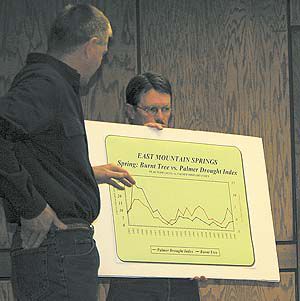| Chuck Semborski, from Energy West shows a graph with the fluctuations recorded over the years at Burnt Tree Spring. Ray Petersen, public lands director holds the chart. |
A report was given by Emery County officials at a taskforce on water and coal mining activities before a legislative task force committee. Energy West Mining was contacted by an upstate newspaper and asked if they would like to comment on their alleged interruption of a spring, one in particular called Burnt Tree Spring.
Chuck Semborski from Energy West took exception to the implication that coal mining activities had interrupted the flow of this spring.
This same water report was given before the Emery County Public Lands council in December. Semborski attended the January meeting to let the council know of their efforts in water monitoring as it relates to coal mining activity.
Semborski said PacifiCorp has been in the mining business since 1972. Utah Power & Light first purchase was the Des-Bee-Dove Mine and then in 1977 they purchased the Peabody holdings which included Deer Creek, Wilberg/Cottonwood. Currently their only active operation is the Deer Creek Mine.
“We take subsidence and hydrological impacts very seriously. We take monitoring very seriously. Our monitoring is often the model other companies use,” said Semborski.
He said they have 26,000 subsidence monitoring points where data is collected on a yearly basis and compared to the baseline. This type of monitoring has taken place since 1977. They have a grid system throughout the entire mining area. In addition to the subsidence monitoring, PacifiCorp conducts helicopter reconnaissance flights over the active areas every August. PacifiCorp monitors ground water, surface water and any water that is discharged from the mines.
“We have an expanded program and we work closely with government agencies. We meet regularly with the irrigation companies, water conservancy district and special service districts.
Semborski showed a large poster with a graph of the water activity at the Burnt Tree Springs. They began monitoring that spring in 1978 before any undermining. The historic use of that spring was for bath water for the shower house at the Des-Bee-Dove mine operation in the 1940s. There was a small cabin in the area that used the spring for water and water troughs were in the area.
This area was undermined twice but PacifiCorp has yet to see evidence that the flow has been impacted. “You just can’t look at isolated points. This is a dynamic thing,” said Semborski. The flow on this spring is measured in July when it is at its peak flow and this monitoring is listed in the permit to take place at this time. Semborski explained they use the weather station on East Mountain as a comparison and also the Palmer drought index to monitor hydrological trends.
Flows are consistent with recorded wet periods in 1982, 1985 and 1986. The flows are not static and have shown fluctuation over the years. At one time Burnt Tree Springs had a nice collection system which is not the case now. It has deteriorated over the years and those sources weren’t re-established. Even if you ignore these changes, the trends at that spring parallel those in the hydrological indices.
PacifiCorp has extensive monitoring to protect its own water rights. PacifiCorp is a major water user in Emery County. “Since the early 70s, we have not detected any spring which we have affected,” said Semborski.
Sherrel Ward from the Public Lands Council and also an officer in the Huntington/Cleveland irrigation company said it’s hard for the irrigation companies to stay on top of things and it would be helpful to them to let them know where mining is taking place and under which spring to help them stay on top of it.
Semborski said they monitored over 200 springs within the hydrological area that are critical to water sheds and drainage. PacifiCorp invites interested parties input in designing hydrologic monitoring programs. PacifiCorp’s mining permit documents state when they will do monitoring and the coal mine plans also tell where the company will be mining. Sometimes, Semborski said a state employee will go with them to become familiar with their monitoring system.
Some monitoring cannot be done until late June to July because of access issues due to snowpack, but as soon as access is available the company does the necessary monitoring. Semborski said he also shares his monitoring information with the Emery Water Conservancy and the North Emery Water users.
“We always monitor more than is required, this protects us from liability,” said Semborski.

